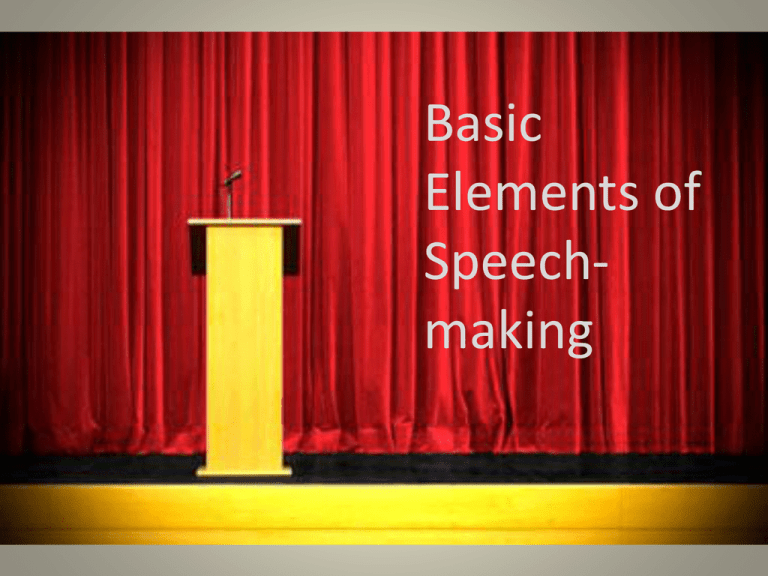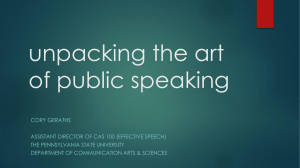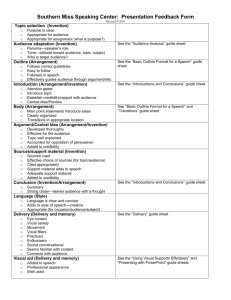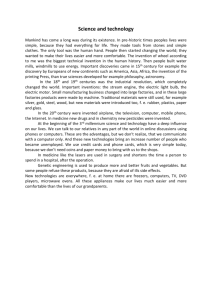Basic-elements-of-Public-Speaking-2
advertisement

Basic Elements of Speechmaking The Five Canons of Rhetoric The Five Canons of Rhetoric (aka Steps in the Process) The Five Canons of Rhetoric (aka Steps in the Process) • • • • • Invention Arrangement Style Memory Delivery The Five Canons of Rhetoric (aka Steps in the Process) • • • • Invention: Finding things to say Arrangement: Organizing the writing Style: Making it beautiful with artful language Memory: Rehearsing and preparing for spontaneity and responsibility • Delivery: Using the voice and body in the moment Invention: Finding things to say Invention: Finding things to Say Invention: Finding things to Say Specific purpose: What you hope to accomplish in the speech for the audience. Invention: Finding things to Say Specific purpose: What you hope to accomplish in the speech for the audience. Example: To persuade my audience to learn to play a musical instrument. Invention: Finding things to Say Brain storm: To persuade my audience to learn to play a musical instrument. Invention: Finding things to Say Brain storm: To persuade my audience to learn to play a musical instrument. Fun, social interactions, relaxation, discipline, helps improve memory and attention, joy of learning, learn about art, learn about history, potentially career opportunities, overcome stage fright, physical rehab from injuries, alternative to other less productive habits Invention: Finding things to Say Organize your initial inventions into categories which can form main points/arguments Invention: Finding things to Say Organize your initial inventions into categories which can form main points/arguments: 1. Cognitive benefits 2. Emotional benefits 3. Social benefits Invention: Finding things to Say Produce a thesis or central idea by summarizing the main points: Invention: Finding things to Say Produce a thesis or central idea by summarizing the main points: Central idea: You should consider learning a musical instrument because of the cognitive, emotional, and social benefits. Invention: Finding things to Say Invention: Finding things to Say • Reasoned Argument (logos) Invention: Finding things to Say • Reasoned Argument (logos) • Emotional Appeals (pathos) Invention: Finding things to Say • Reasoned Argument (logos) • Emotional Appeals (pathos) • Appeals to character, values, or ways of life (ethos) Invention: Finding things to Say Aristotle calls these “artistic elements/proofs” • Reasoned Argument (logos) • Emotional Appeals (pathos) • Appeals to character, values, or ways of life (ethos) Invention: Finding things to Say • • • • • Data Statistics Quotations from experts Testimony from witnesses Other facts, laws, and important information Invention: Finding things to Say Aristotle calls these “inartistic proofs” • Data • Statistics • Quotations from experts • Testimony from witnesses • Other facts, laws, and important information Arrangement Arrangement • Make sure each main point is well developed (with its own introduction, development, and conclusion) Arrangement • Make sure each main point is well developed (with its own introduction, development, and conclusion) • Main points should be distinct, comprehensive, and they should “add up to” the thesis. Arrangement • Make sure each main point is well developed (with its own introduction, development, and conclusion) • Main points should be distinct, comprehensive, and they should “add up to” the thesis. • Link your points with transitions that summarize and preview: (“Now that I’ve told you about X, next I will tell you about Y.) Arrangement Introductions need: Arrangement Introductions need: 1. Grab the attention from the first line Arrangement Introductions need: 1. Grab the attention from the first line 2. Reveal the topic in a line or two Arrangement Introductions need: 1. Grab the attention from the first line 2. Reveal the topic in a line or two 3. Establish your credibility Arrangement Introductions need: 1. Grab the attention from the first line 2. Reveal the topic in a line or two 3. Establish your credibility 4. Culminate in your thesis Arrangement Conclusions need: Arrangement Conclusions need: 1. Signal the end of the speech has arrived Arrangement Conclusions need: 1. Signal the end of the speech has arrived 2. Summarize and reiterate the main ideas Arrangement Conclusions need: 1. Signal the end of the speech has arrived 2. Summarize and reiterate the main ideas 3. Amplify the significance of the speech for this audience in this time and place. Arrangement Conclusions need: 1. Signal the end of the speech has arrived 2. Summarize and reiterate the main ideas 3. Amplify the significance of the speech for this audience in this time and place. 4. End with a meaningful last line. Style Style • Aristotle argues that the two most important stylistic virtues in public speaking are clarity and appropriateness. Style • Aristotle argues that the two most important stylistic virtues in public speaking are clarity and appropriateness. • Write for the ear…not the eye. Style • Aristotle argues that the two most important stylistic virtues in public speaking are clarity and appropriateness. • Write for the ear…not the eye. Read your work ALOUD. Style • Aristotle argues that the two most important stylistic virtues in public speaking are clarity and appropriateness. • Write for the ear…not the eye. Read your work ALOUD. • Avoid phrasing that might be distracting, too ambiguous, or bad for your ethos (e.g. gendered language, slang, etc.) Memory Memory • Rehearse the ideas of the speech, rather than the specific wording. Memory • Rehearse the ideas of the speech, rather than the specific wording. • Rehearse success (don’t rehearse failure…) Delivery Delivery Delivery BREATHE Delivery • Body: alert upright posture, relaxed arms and hands, meaningful gestures Delivery • Body: alert upright posture, relaxed arms and hands, meaningful gestures • Voice: Appropriate rate, pitch, volume, pauses Delivery • Body: alert upright posture, relaxed arms and hands, meaningful gestures • Voice: Appropriate rate, pitch, volume, pauses • Eyes: Panoramic and intimate





